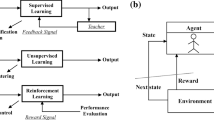Abstract
Attitude detection of cooperative robots can help robots recognize environment, understand tasks, and improve the safety, accuracy and efficiency of robot work. For robots with unknown configuration parameters, their configuration can be estimated; it is convenient for further kinematics and dynamics analysis. For an economical cooperative robot, its kinematic parameters can be corrected by attitude detection. An independent robot attitude detection system can be used as a secondary auxiliary system, and the fault diagnosis system of the robot is composed of the high-precision encoder system of the robot body. This paper studies the neural network control system of cooperative robot based on genetic algorithm. In this paper, the robot is taken as the research object. Aiming at its strong conjunction, non-linearity and multivariable characteristics, the problem of robot motion control based on neural network is mainly discussed. On this basis, the basic genetic algorithm and an improved genetic algorithm called messy are used to optimize the structure of the neural network, so as to better realize the motion control problem of the robot. The results of this study show that: After optimization with messy genetic algorithm, not only the tracking effect is better, but also the number of hidden layer nodes of the network is reduced from 12 to 7. This greatly simplifies the structure of the network and makes the design and training of the network relatively simple.









Similar content being viewed by others
References
Du L, Bo S, Liu Y et al (2017) Genetic algorithm-based compliant robot path planning: an improved Bi-RRT-based initialization method. Assem Autom 37(2):00–00
Liu C, Kroll A (2016) Performance impact of mutation operators of a subpopulation-based genetic algorithm for multi-robot task allocation problems. Springerplus 5(1):1361
Nakashima M, Maruyama Y, Umeda N et al (2015) Basic experiments on robot-base vibration control of the hot-line work robot system using genetic algorithm. IEEJ Trans Ind Appl 123(2):40–52
Peng JI, Song A, Changcheng WU et al (2017) Human–robot–robot-cooperation based uncalibrated visual servoing control for mobile robotic manipulators without joint-state feedback. Robot 39(2):197–204
Ibrahim AO, Shamsuddin SM, Abraham A et al (2019) Adaptive memetic method of multi-objective genetic evolutionary algorithm for backpropagation neural network. Neural Comput Appl 31:4945–4962
Nedic N, Stojanovic V, Djordjevic V (2015) Optimal control of hydraulically driven parallel robot platform based on firefly algorithm. Nonlinear Dyn 82(3):1–17
Yin YA, Watanabe K, Maeyama S et al (2016) An automatic parking system using an optimized image-based fuzzy controller by genetic algorithms. Artif Life Robot 22(1):1–6
Zhang J, Meng Q, Feng X et al (2018) A 6-DOF robot-time optimal trajectory planning based on an improved genetic algorithm. Robot Biomim 5(1):3
Perng JW, Hsieh SC, Ma LS et al (2016) Design of robust PI control systems based on sensitivity analysis and genetic algorithms. Neural Comput Appl 29(4):1–11
Duvvuri SP, Anmala J (2019) Fecal coliform predictive model using genetic algorithm-based radial basis function neural networks (GA-RBFNNs). Neural Comput Appl 31:8393–8409
Chen RC, Huang SW, Lin YC et al (2015) An indoor location system based on neural network and genetic algorithm. Int J Sens Netw 19(3):204–216
Muhuri PK, Rauniyar A (2017) Immigrants based adaptive genetic algorithms for task allocation in multi-robot systems. Int J Comput Intell Appl 16(1):1750025
Yang Y, Chen Y, Shi J et al (2016) An improved grey neural network forecasting method based on genetic algorithm for oil consumption of China. J Renew Sustain Energy 8(2):024104
Huang HC, Chiang CH (2016) An evolutionary radial basis function neural network with robust genetic-based immunecomputing for online tracking control of autonomous robots. Neural Process Lett 44(1):19–35
He W, Ge SS, Li Y et al (2015) Neural network control of a rehabilitation robot by state and output feedback. J Intell Robot Syst 80(1):15–31
Waldock A, Carse B (2016) Learning a robot controller using an adaptive hierarchical fuzzy rule-based system. Soft Comput 20(7):2855–2881
Van Cuong P, Nan WY (2016) Adaptive trajectory tracking neural network control with robust compensator for robot manipulators. Neural Comput Appl 27(2):525–536
Azimirad V, Alimohammadi M, Joudi A et al (2015) Analysis of PSO, AIS and GA-based optimal wavelet-neural network classifier in brain–robot interface. IRBM 36(4):240–249
Jiang X, Wang Z, Zhang C et al (2015) Fuzzy neural network control of the rehabilitation robotic arm driven by pneumatic muscles. Ind Robot Int J 42(1):36–43
Chang SJ, Lee JY, Jin BP et al (2015) An online fault tolerant actor-critic neuro-control for a class of nonlinear systems using neural network HJB approach. Int J Control Autom Syst 13(2):311–318
Acknowledgements
This study was supported by Grant No. 2018GSF118221 and No. 2019JZZY011101 from the Key Research and Development Program of Shandong Province to Dianmin Sun.
Author information
Authors and Affiliations
Corresponding author
Ethics declarations
Conflict of interest
These no potential competing interests in our paper. And all authors have seen the manuscript and approved to submit to your journal. We confirm that the content of the manuscript has not been published or submitted for publication elsewhere.
Additional information
Publisher's Note
Springer Nature remains neutral with regard to jurisdictional claims in published maps and institutional affiliations.
Rights and permissions
About this article
Cite this article
Liu, A., Zhang, Y., Zhao, H. et al. Neural network control system of cooperative robot based on genetic algorithms. Neural Comput & Applic 33, 8217–8226 (2021). https://doi.org/10.1007/s00521-020-04952-1
Received:
Accepted:
Published:
Issue Date:
DOI: https://doi.org/10.1007/s00521-020-04952-1




